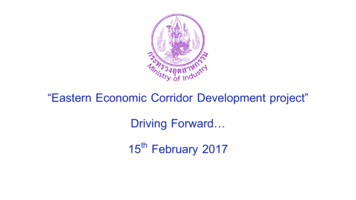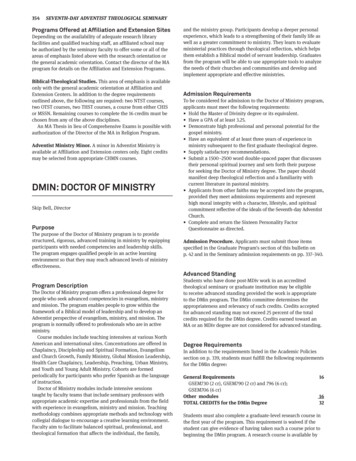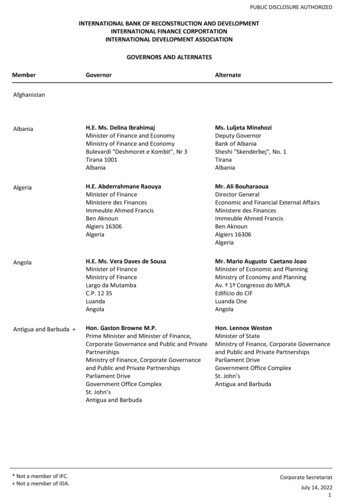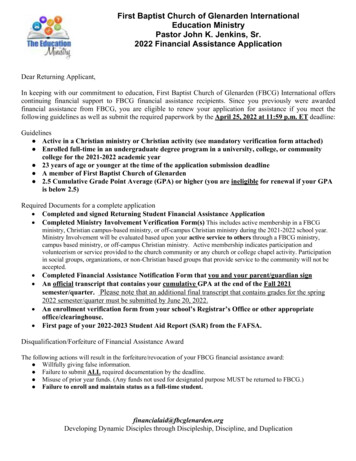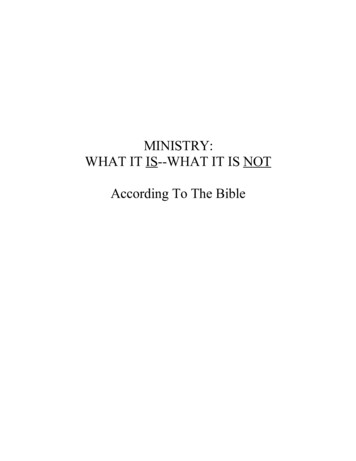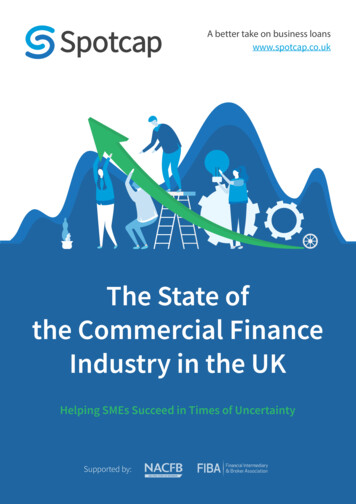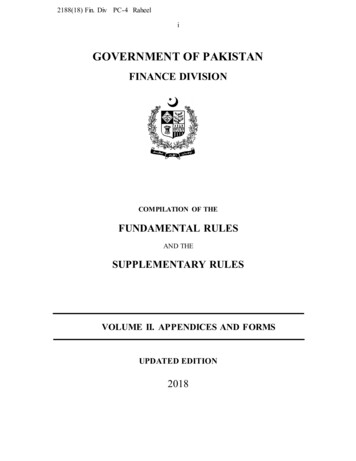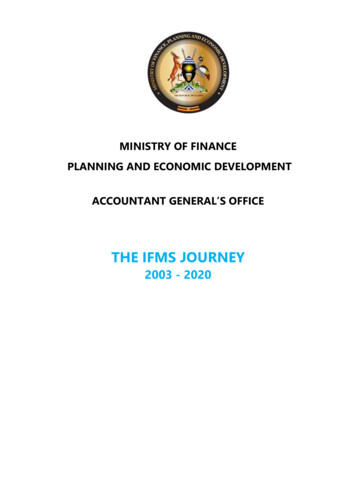
Transcription
MINISTRY OF FINANCEPLANNING AND ECONOMIC DEVELOPMENTACCOUNTANT GENERAL’S OFFICETHE IFMS JOURNEY2003 - 2020
Document ControlVersion1.0Author / UpdatedRogers Baguma1.1Rogers Baguma1.2Rogers BagumaReviewed byAiden RujumbaCommissioner, FMSDAiden RujumbaCommissioner, FMSDAiden RujumbaCommissioner, FMSDReviewed byGodfrey SsemugoomaDirector, FMSDGodfrey SsemugoomaDirector, FMSDDateApril 2020May 2020June 2020
Contents1 INTRODUCTION . 91.1 IFMS . 91.1.1 The Integrated Financial Management System . 92 IFMS OPERATION . 112.1 IFMS MODULES . 112.2 IFMS DATA LINKS . 113 BRINGING UP AN IFMS SITE . 133.1 PRE-REQUISITES FOR IFMS . 133.1.1 Infrastructure Readiness. 133.1.2 Survey Process and Reporting. 133.1.3 Other Feasibility Measures . 133.2 THE IMPLEMENTATION PROCESS . 143.2.1 Project Plan . 143.2.2 Sourcing for Service Providers and Procurement of Equipment . 143.2.3 Site Preparation . 153.2.4 Master Data Gathering . 163.2.5 Systems Setups / Configuration . 163.2.6 User Acceptance Testing . 173.2.7 Training . 173.2.8 Commissioning . 183.2.9 Change Management . 183.2.10Going Live. 184 THE GROWTH PATH . 204.1 IFMS SITES AND IMPLEMENTATION TIMELINES . 204.1.1 Timelines (Pilot and Rollout) . 204.2 SITE STATISTICS . 214.3 USERS GROWTH PROFILE . 224.4 PROCESS ENHANCEMENTS. 224.4.1 Functional Enhancements . 224.4.2 Software Enhancements . 224.5 KEY REFORMS FACILITATED BY IFMS . 244.5.1 Electronic Payments . 244.5.2 Straight Through Processing. 244.5.3 Treasury Single Account . 244.5.4 Decentralisation of Payroll Payment Processing . 244.5.5 Heads of Department control over their cost centre budgets . 244.5.6 Automatic Generation of Periodic Financial Statements . 244.5.7 Activation of a Fixed Assets Module . 254.5.8 Electronic Purchase Orders. 254.5.9 Electronic Tracking of Appropriation-In-Aid 2016 . 254.5.10Electronic Cash Transacting . 254.5.11Governance, Risk and Compliance Measures . 254.6 INTERFACING WITH OTHER SYSTEMS . 264.6.1 Building Interfaces . 264.7 PHYSICAL INFRASTRUCTURE . 271
4.7.1 Data Centre Infrastructure . 274.7.2 Site Infrastructure . 274.8 DATABASE MANAGEMENT . 284.9 APPLICATION MANAGEMENT . 285 STAYING AFLOAT (SYSTEM MAINTENANCE) . 295.1 EQUIPMENT STATISTICS . 295.2 PHYSICAL EQUIPMENT MAINTENANCE . 295.2.1 Maintenance Agreements . 295.2.2 Memoranda of Understanding . 305.3 SYSTEM SOFTWARE MAINTENANCE . 305.3.1 System Monitoring . 305.4 SYSTEMS SUPPORT . 315.4.15.4.25.4.35.4.45.4.5On Site Support . 31Remote Support . 31Training . 31Treasury Service Centre . 31Other Support Resources . 326 LESSONS LEARNT . 346.1 PEOPLE. 346.1.16.1.26.1.36.1.46.1.56.1.66.1.7Managing the fear of change is critical to adoption of systems . 34Adequate staff is vital for the optimal operation of IFMS . 34There is a Learning Curve for all users new to systems . 34Frequent loss of staff can be detrimental to IFMS operations . 34Timely transaction processing should be emphasised . 34Using IFMS as a scapegoat should be avoided . 35Resident IT Personnel play a key role in support to IFMS . 356.2 EQUIPMENT . 356.2.1 IFMS equipment must be regularly and properly maintained . 356.3 SYSTEMS. 356.3.16.3.26.3.36.3.46.3.5The high birth rate of government votes affects implementation timelines . 35A single system is preferable to multiple systems for efficient financial management . 36Lower tier systems do not necessarily translate into cost savings. . 36Non-financial functions can be better addressed by other systems . 37Government operations are growing faster than existing data centre infrastructure . 376.4 INFRASTRUCTURE . 376.4.16.4.26.4.36.4.4IFMS implementation is affected by votes without or poor premises (buildings) . 37A source of power is essential to the implementation of IFMS . 37Dirty and unstable power can result in unexpectedly high maintenance costs . 37Reliable telecommunication networks play a big role in IFMS operations . 386.5 OTHERS . 386.5.1 Measures should be available to counteract Natural Disasters (Acts of God) . 386.5.2 Safeguards against Theft and Vandalism must be put in place . 387 LOOKING FORWARD (THE FUTURE OF IFMS) . 397.1 THE FUTURE AT A GLANCE . 397.2 EXTENDING THE IFMS . 397.2.1 Local Governments . 397.2.2 Missions . 397.2.3 Donor Funded Projects . 392
7.3 EXPANDING IFMS FUNCTIONALITY . 397.3.1 Self-Service Password Management . 397.3.2 Information Dashboards . 407.3.3 Processing Refunds On IFMS . 407.4 A SINGLE TREASURY ACCOUNT FOR GOVERNMENT . 407.5 REMOTE ACCESS TO THE IFMS . 417.5.1 IFMS On the Internet (WAN) . 417.5.2 IFMS On Mobile Platforms . 417.6 WIDER SYSTEMS AUGMENTATION . 417.6.1 Seamless Integration with other Government Systems . 417.6.2 Use of Blockchain Technology . 437.7 A BROADER, LONGER OUTLOOK OF PFM SYSTEMS . 437.7.1 The move to cloud . 447.7.2 Advanced Mobile Features . 447.7.3 The Use of Artificial Intelligence . 457.7.4 Support for Internet of Things . 467.7.5 Big Data Analytics . 477.7.6 Context Aware Business Intelligence . 477.7.7 Triggering Innovation . 487.7.8 Integration of Multiple Complementary Systems . 487.7.9 Promotion of Local Solutions. 487.7.10Value addition to the citizens of Uganda . 483
List of DiagramsDiagram 2.1-1 IFMS Operation - Modules . 11Diagram 2.2-1 IFMS Data flow . 12Diagram 3.2-1 IFMS service provision procurement process . 15Diagram 4.1-1 IFMS Piloting and Rollout . 21Diagram 4.4-1 Enhancements to IFMS. 23Diagram 4.5-1 IFMS interfaces with other systems . 26Diagram 7.3-1 Proposed TSA structure . 41Diagram 7.5-1 Integration Platform Overview. 42Diagram 7.5-2 Integration Platform and Public Services . 42List of TablesTable 3.1-1 IFMS Users and their roles . 14Table 3.2-1 Site preparation works . 15Table 3.2-2 User training. 17Table 4.1-1 IFMS pilot sites . 20Table 4.2-1 IFMS implementation statistics by vote category . 21Table 4.7-1 Database updates . 28Table 4.8-1 Software application updates . 28Table 5.1-1 IFMS equipment statistics . 29Table 5.4-1 TSC regional centres . 32List of GraphsGraph 4.3-1 Growth of IFMS users . 22Graph 6.4-1 Growth of districts . 364
FOREWORDGovernment seeks to have excellent and sustainable public financial management that enables social economictransformation. Several reforms have been pursued to-date with the aim of attaining value for money in themanagement of public resources as a basis for improved service delivery.The primary objective of Government’s PFM reform programme is to improve the efficiency and effectiveness offinancial management processes, with the goal of enhancing the quality of public service delivery in Uganda. Priorto the implementation of PFM reforms, the Government’s fiscal management processes were characterized by severalloopholes and weaknesses. To address many of the weaknesses, Government adopted reform strategies aimed atpromoting economic growth while ensuring that critical fiduciary risks were minimized.Key to the achievement of these reforms was the establishment of an Integrated Financial Management system(IFMS), a process that commenced in 2002. Significant progress in strengthening the PFM systems and other relatedbusiness processes re-engineering have impacted the efficiency and effectiveness of government operations,changing how we work and think about financial management. Am especially pleased by the leaps and bounds thathave been made in financial literacy brought about by IFMS through various training and support programs. Am alsocognisant of the challenges encountered in the implementation and growth of IFMS as well as the efforts made ingenerating solutions.Enhancements to PFM systems have been made possible by a conducive environment covering a robust PFM legaland regulatory framework, enhanced capacity of PFM staff, strong leadership and ownership of the these reform,effective training initiatives, dedicated support team and collaboration amongst key stakeholders.As government processes and procedures become more advanced, so do systems which must continuously evolveto meet this challenge. Government continues to consolidate and strengthen financial reforms while steadfastlyadvancing into a future that will undoubtedly be heavily reliant on digital technology which offers an unparalleledtool to re-design public service, engage the public and reconfigure the relationship between citizens and theirgovernment.This document provides an insight into implementation of systems and what it takes to maintain financialmanagement systems. While by no means exhaustive, it is sufficient to provide an understanding of the direction inwhich government is moving as far as financial management is concerned. It has been well worth the effort as IFMShas paved the way for multiple financial management reforms, including the Treasury Single Account Frameworkamong others5
6
ACRONYMSNo 849505152535455Application Access Controls GovernorAdvanced Encryption StandardsAcademic Information Management SystemAir TelecommunicationsBOU Banking SystemBusiness IntelligenceBank of UgandaConfigurations Control GovernorData CentreDebt Management and Financial Analysis SystemData Termination UnitE-Business SuiteElectronic CashEconomic and Financial Management Programme IIElectronic Government InfrastructureElectronic Government ProcurementElectronic RegistrationElectronic TaxFrequently Asked QuestionsFinancial YearGovernment Finance StatisticsGovernance Risk and ComplianceHewlett PackardIntegrated Financial Management SystemiPhone Operating SystemInternet of ThingsIntegrated Personnel and Payroll SystemInformation TechnologyiWay AfricaKlynveld Peat Marwick GoerdelerLocal Area NetworkMobile Telephone NetworkNavisionNational Backbone InfrastructureNetwork Based ServicesNational Information Technology Authority - UgandaOperating SystemProgramme Based Budgeting SystemPreventive Controls GovernorPublic Financial ManagementProject Management TeamPublic Procurement and Disposal of Public Assets AuthoritySegregation of DutiesStraight Through ProcessingTreasury Single Sub-AccountTransaction Control GovernorTreasury Single AccountTreasury Service CentreUser Acceptance TestingUganda Electricity Transmission Company LimitedUser InterfaceUninterruptible Power SupplyUganda Telecom LimitedVirtual Private NetworkWide Area CASHEFMP ub-TSATCGTSATSCUATUETCLUIUPSUTLVPNWAN7
8
1 INTRODUCTION1.1 IFMS1.1.1 The Integrated Financial Management SystemThe availability of information is a prerequisite for economic and financial management improvement. TheGovernment of Uganda had historically faced major problems of inaccurate, untimely, and inappropriatebudget and accounting information. This was characterized by manual and semi-automated systems,inadequate systems for collection and tracking of revenue, backlog of un-reconciled bank accounts, lackof a uniform Chart of Accounts that complied with Government Finance Statistics (GFS), endemic budgetoverruns, ad-hoc and uncoordinated IT acquisitions; and non-compliance with international public sectoraccounting standards.Government commissioned a Fiscal Management Systems Study (FMS) that took place between October2001 and April 2002. Ernst & Young Consultants undertook the FMS study. The study aimed at developinga framework of the principles and standards for the introduction of government wide IT based FiscalManagement Systems that would meet current and future needs. The consultants prepared and submittedan Information Technology Architecture and Plan (ITAP) report detailing the recommended business andinformation processes as well as the User Requirements Specifications and proposed technology options.Following a selection process closely supervised by GoU and the World Bank, a contractor, M/s HewlettPackard (HP) was contracted to implement the IFMS. HP was assisted by a number of sub-contractorsamong them Oracle Systems Limited, Computech Uganda Ltd, Venture Communications Group Ltd and RPCData Ltd. A turnkey concept was adopted where GoU held one supplier (HP) responsible and accountablefor all the deliverables including those of the sub-contractors. HP was responsible for the supply,installation, integration, testing, commissioning and providing the related support services for the IFMISsolution under this arrangement. The costs for IFMS implementation were financed with assistance fromthe World Bank and other Development Partners. GoU also allocated counterpart funds in the budget tosupport the IFMS implementation.Government’s commitment to elimination of financial malpractices and wasteful public spending is set outin various PFM strategies, which recognise that achieving overall PFM improvements requires acombination of the suitable policy changes, political commitment to reforms and the design andimplementation of appropriate systems and tools to enable better outcomes from the government policies.The IFMS was set up with these main objectives.1. Improving fiscal management, thereby achieving timely, accurate financial information for Localand Central government.2. To ensure transparency and accountability in the handling and use of public resources.3. To strengthen the Government financial management processes and provide better expenditurecontrols.4. To enhance operational effectiveness by improving data quality and making it available for use andsharing.5. To standardize and automate Government financial management processes, reducing redundanttasks.6. To maximize the cost effectiveness of the expenditure of public funds.7. To improve revenue management.9
The Uganda Integrated Financial Management Information System (IFMS) replaced all stand-alone legacyFinancial Management Systems in MALGs and DFPs.10
2 IFMS OPERATION2.1 IFMS MODULESIFMS bundles many essential financial management functions into one Oracle based software suite. TheOracle E-Business Suite provides a set of financial applications used by government that encompasses allkey business processes. These applications are grouped into "suites", defined as sets of common,integrated applications designed to execute specific business processes. Oracle Financials encompassesclosely related financial modules of Purchasing, Accounts Payable, Accounts Receivable, Cash Management,Fixed Assets and General Ledger.The key business proce
9 DC Data Centre 10 DMFAS Debt Management and Financial Analysis System 11 DTU Data Termination Unit 12 EBS E-Business Suite 13 E-CASH Electronic Cash 14 EFMP II Economic and Financial Management Programme II 15 EGI Electronic Government Infrastructure 16 EGP Electronic Government Procurement 17 E-REG Electronic Registration 18 E-TAX Electronic Tax
